You are here
Sights monuments of Bukhara.
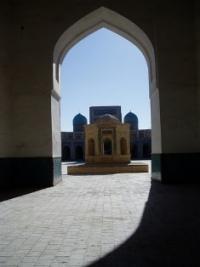
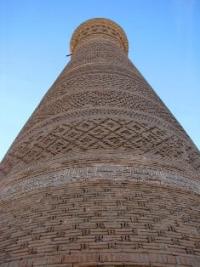

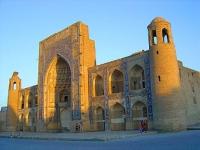
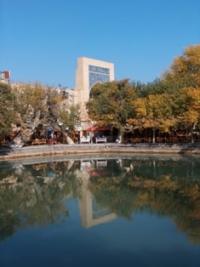
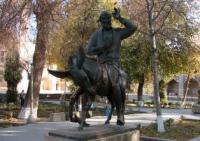
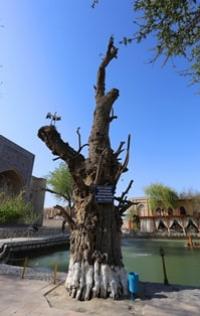


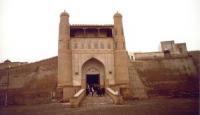

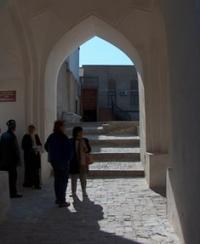

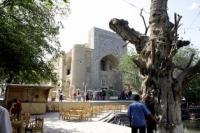
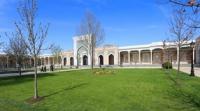

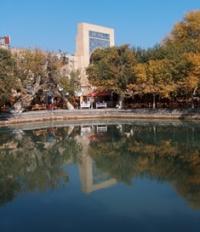
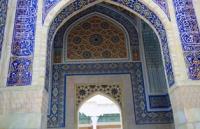
Excursions to architectural monuments of Bukhara.
“Our road led to the Darvaz-Imam gate located in the eastern part of the city, but we didn’t enter through them, because then we could get to our tekka, to the north, only through the bustle of the bazaar. Therefore, we drove around the city wall, which had large cracks in many places, and having entered through the Darvaz-Mazar gate, arrived on July 12 in a spacious tekke surrounded by beautiful trees, forming a regular square with 48 cells on the first floor. His current chapter (chalf) is the grandson of the half-famous Hussein, whose name bears the name of tekke. The great honor that is still being given to this family is already indicated by the fact that the grandson was imam and hatib, i.e. court priest of the emir. I was much proud of this official post of our host "
Vamberi Arminius.
Architectural monuments of Bukhara.
In the expanses of Central Asia, hundreds of architectural monuments of all eras are scattered. Time is powerless to erase the beauty of form and ornament, their ruins are fanned by the breath of centuries. Especially many works of architecture are concentrated in Bukhara and Samarkand.
These cities, the centers of the vast medieval states, for centuries challenged each other the glories of capitals and rarely conceded hegemony to other cities of Central Asia. There was going to "color" of science and art, historical works and masterpieces of poetry were created, political plans matured, skilled architects built palaces, mosques and tombs.
Many of these brilliant constructions have not existed for a long time, but you can re-create history Central Asian architecture. In the lower reaches of the Zeravshan, where the river, which had already given its waters to the fields and gardens, was lost in the reeds, emerged in the 6th century. city of Bukhara.
The appearance of pre-Muslim Bukhara appears unclearly in the “History of Bukhara". From this essay, written by the author of the tenth century Narshahi, we learn that the walled city was divided into quarters; the sanctuary of fire was built; that the ruler Bidun erected in the citadel a palace "on seven pillars" like the stars of Ursa Major; that the Arabs who captured Bukhara ousted the Kashkashan merchants, who had built "700 castles" in the suburbs with reliefs on the gates.
The monuments of those times in Bukhara will probably never be opened, since, unlike many others, the city always remained in one place and new buildings covered the remnants of the previous ones. About the architecture and art of the time, excavations of Varakhsha, 30 km from Bukhara, give a presentation it was a fortified city residence, where the palace of the ruler-bukharhudat stood under the protection of the high corrugated walls of the citadel.
The palace was rebuilt more than once; the halls of the 7th century were decorated with wall paintings; , fish and animals, musicians and dancers. territory of Bukhara of the 8th century, significant for its time, reached 35 hectares, seven walls were cut through the walls, the citadel stood separately to the west of the city.
In the 10th century, Bukhara was the capital of the vast state of the Samanids, who advanced from among the local (Tajik) aristocracy. After years of submission to the Arab Caliphate, an economic and cultural revival began. Bukhara becomes the focus of science and the arts.
The greatest medieval scholars and poets lived and worked here, the palace library of Bukhara competed with Shiraz. Here advanced ideas in the field of architecture matured, which responded to a new social and technical program, and new forms and types of buildings were composed.
The bulk of the building was, apparently, frame buildings with a beam roof. It is known that the fire of 937 destroyed many buildings. But the architects of that time perfectly mastered the construction of baked. With the development of feudal relations, the structure of the city is changing: the old urban core of Shahristan is overgrown with a trade and craft suburb, where a busy business life is in full swing; the new building is surrounded by an outer ring of walls with eleven gates.
The western gate of the citadel overlooks a large area of Registan. Jui-Mulian, irrigated by a network of canals, among the greenery of flower gardens stood palaces. The only surviving building of Samanid Bukhara, Samanid mausoleums, dates back to the IXth - Xth centuries.
The square domed building in the northwestern part of the city is now restored and surrounded by a garden. This earliest surviving tomb begins a series of brilliant memorial monuments. A relatively small (10 x 10 meters) building, however, is extremely monumental in nature.
The composition of the mausoleum with equivalent facades is strictly centric. Slightly expanded to the bottom cubic volume with arches open on four sides and angular massive columns ends with a light arcature gallery.
The logical and finished composition with the crowning hemisphere of the large dome is completed in the corners by four miniature cupolas. In one of the facade arches there is a door, the others are locked with a brick lattice.
Thick walls of square limestone bricks are lined on the outside and inside with embossed masonry, the design of which is different in the lower and upper parts of the walls. The arches on the cylindrical columns are enclosed in ornamental frames with patterned alabaster inserts. Inside the quadrangular walls and the dome are separated by an octagonal tromp belt, this part of the building represents the culmination of the disclosure of architectural design, a kind of final chord in the harmony of forms.
In general and in details, the domed area with its angular arches, miniature columns, and a border of rosettes is a miracle of perfection. The side arches and the tromp are connected to the elegant exterior gallery, illuminating the domed space.
At the same time, monumental and airy, saturated with light, playing with shadows in masonry reliefs, the building remains a classic work of Central Asian architecture, reflecting forms of Sogdian architecture: the crowning arcature, columns of the tromp belt and ornamental elements copy the wooden parts discovered during the excavations of ancient Penjikent, a major cultural and artistic center VII - VIII centuries. in the middle course of the Zeravshan. In the forms of the mausoleum laid the idea of calm dignity, durability, inviolability.
Life was in full swing in Bukhara and the Karakhanids in the XI-XII centuries. In these centuries, technical thought improves the design of coatings, forms a clear artistic concept, and refines the craftsmanship of the part. The building is revealed outside by the portal portal, to which the architect pays the main attention.
This portal viewer assesses first. The success of the relief brickwork is fixed and developed in the rich ornamentation of the facade, enriched with carved terracotta with floral patterns and inscriptions. Refined and refined style of architecture XI - XII century.
It is represented in Bukhara by monuments of a few, but distinguished by high artistic merit. Burnt brick is widely used as an element of the ornament, it is polished and driven without a solution. The masonry captivates not only geometric combinations, but also a range of yellow and pink tones.
Colorful efsrskkt contribute turquoise glaze, interspersed with individual bricks and inserts. In the Magoki Attari mosque, a room with domes on six round pillars lacks decoration, but its portal was designed in emphatically festive forms.
The portal arch on graceful columns accepts a counter semi-arch in the castle (the same design as in the Samanids mausoleum tromp) and both are covered with italics carved in terracotta, and the corners are filled with “stalactites” - characteristic feature of the architecture of the medieval East.
On the alabaster-geometrical pattern, the brickwork forms the rollers, and the portal pylons are decorated with opposite quarter columns laid out of paired polished bricks with dividing patterned inserts. It revives the old tradition of "corrugated walls" typical of fortifications VII - VIII centuries
The minaret of the cathedral Friday mosque rose above each large city, creating a special memorable silhouette of the building. Usually in Muslim countries any minaret was distinguished by its size and beauty. In medieval Andalusia, this is the Giralda tower 73 meters high; in Morocco, the minaret of Koutoubia.
India is famous for Delhi Qutb Minar, a height equal to the Giralda; in Afghanistan, Jama minaret is amazing. Ii Central Asia is widely known one of the masterpieces of medieval architecture - the Bukhara minaret Kalyan.
It gives a complete picture of the forms of the Central Asian minarets: a round, widened tower with a steep spiral staircase inside, topped with an arcature of a lantern and a stalactite cornice. With a high altitude of minarets, their construction required experience and outstanding craftsmanship - it was necessary to take into account the strength of the wind and seismic shocks, the properties of soils.
The height of the Kalyan minaret (45.6 m) is far from complete, since its base is hidden by age-old stratifications.
Its surface is covered with a relief brick pattern, divided into ten ornamental belts, marked with intermediate edges on the edge. At the middle of the height, the inscription from burnt brick contains the name of the ruler Arslan Khan and the date of 1127. The peaked minaret of Kalyan is visible many kilometers from Bukhara.
The Namazgo suburban mosques were a walled open space for citywide prayer performed on large annual holidays, a wall with a prayer niche-mihrab indicated the direction to Mecca. The wall with mih-slave in Bukhara namazgo refers to 1119 - 1120 years.
In this work, the technique of thin undersized polished brick, playing with yellow-pink tones and geometric patterns and inscriptions, has reached a special perfection. A three-span dome canopy with a portal was erected in front of the wall already in the XVIth century.
In 1220 the Mongol hordes flooded the country, and a long break in construction activity began. The revival of economic and cultural life and the XIV century. noted in Bukhara by the construction behind the Karshinspmp gate of the mausoleum of the thirteenth-century theologian Saifed-din Bokharsi.
The modest two-dome building consists of the tomb ,, gurkhany "and the chapel ,, znrahkhany". Deprived of both external and internal decor, the building enclosed a treasure of ornamental art - a carved wooden tombstone covered with the finest three-sided carvings of geometric and plant patterns (on display in the Bukhara Regional Museum of Local History).
Not far away and a little behind the Saifeddin Boharzi mausoleum stands the Buyan-Kulihan mausoleum of the second half of the 14th century. In the plan, it is also divided into two domed rooms, in the thickness of its side and rear walls at half the height lies a deaf dark corridor of unknown purpose.
His portal, as in the next building, stands only at the height of the facade. The miniature building was covered inside and outside with a wonderful decor of glazed carved terracotta. Still only weakly outlined in the XII century. this type of ornament reaches full bloom here.
Deep carving will convey the floral motifs enclosed in the geometric base of the pattern. The linings are blue-tinted: a wonderful green-blue shade of seawater dominates, complemented by manganese blue and white. The trompas of the main domed room are filled with stalactites, also made in the technique of carved irrigated terracotta.
Although the monument has retained only a small fraction of its glazing facings, the merits of carved irrigation décor push it into the ranks of the best works of Central Asian architecture. In close proximity to the Samanid mausoleum, Chashma-Lyub (the source of Job) is located - the mausoleum of a prominent person, erected (or rather rebuilt) in 1379 - 1385.
A well was dug in the lobby - hence the popular name of the building. The appearance of this building is unusual for Bukhara. A conical dome on a cylindrical drum will give out the hand of the Urgench architect - in those years Timur gathered architects from Khorezm he had subdued, and although they were busy building his native Shakhrisyabz, one of the trowels in the renovation of the Bukhara mausoleum, whose initial construction relates the tradition to the XII century. In any case, only this monument remained in Bukhara from the time of Timur's rule.
There are few buildings in Bukhara from the time of Timurids, who built more in Samarkand XV and. However, in the XV century. and there are two large buildings erected here. The cathedral mosque of Bukhara was rebuilt - the Kalyan mosque, originally a building of the XII century, to which the minaret of the same name belonged.
The composition of the building is typical of large mosques of Central Asia, Iran, Afghanistan: a rectangular courtyard, surrounded by arched galleries with four high portals. The galleries are covered with domes on square pillars.
The ceremonial portal enters the adjacent square, and there is a closed hall opposite the entrance under a glaze turquoise dome on the drum. Portals are dressed with irrigated majolica and mosaic décor. The hanging bridge connects the roof of the mosque with the spiral course of the Kalyan minaret.
The huge building covers an area of 127 x 78 meters. The enlightened ruler Ulugbek built in the XV century. three big madrasas (schools). One of them, the oldest surviving in Central Asia, was completed in 1417. It stands in the center of Bukhara.
The building forms became the benchmark for all later large buildings of this purpose, developing the initial Bukhara prototype. A vaulted portal leads to the courtyard, on both sides of which are domed halls - a mosque and an audience; the bottom with portals on the main axis bends around in two tiers of hudjra - students' cells, vaulted and open to the facade by a row of arches.
The corners of the main facade are fixed with round towers, and the areas between the portal and the towers are occupied by arches in two tiers. The facades are decorated with mosaic tiles and majolica. The arch of the external portal is framed with a harness, which is typical of the XV century.
The doors of the massive door of the type-work are covered with beautiful carvings, combining elements of geometric and plant patterns with inscriptions. The fullest flourishing fell on the share of Bukhara in the XVI and. (1530), when it became the center of the state of Sznbanpdov.
The center of political and cultural life of the vast power, the pillar of the Sunni theology of the entire Middle East and the center of its shrines, the city experienced an unprecedented flourishing. The territory of the city, extended and re-surrounded by a wall with a perimeter of up to 10 km, has reached its present size, the appearance has finally formed (the feudal Bukhara with winding streets running from the old core to the gate and interspersed among the flat-roofed houses of monumental dome buildings with preserved city walls with Sheikh Jal preserved walls).
Considerable attention was paid to the improvement of the city, which was built up with covered markets and baths, and was supplied with water from the Shahrud main canal. The ponds-houses were marked in the city plan by the nodes, where the city a life.
Their stepped banks are lined with stone. The water was supplied by marble trays in the shape of a lion's head or a dragon. Along the narrow streets at the facade of madrasas and mosques, unloading areas-pockets stood out. Architects XVI century.
Attached great importance to the ensemble, in the urban areas and suburbs are perfectly solved complexes. In Bukhara, there are many “cat” ensembles (literally, “pair”) of buildings set on the same axis to meet each other. Thus, in the heart of the city, a wonderful ensemble of the Kalyan mosque and the Miri-Arab madrasa (1535 – 1536) arose.
A large two-story madrasa with four courtyard portals can accommodate 110 hujras. His plan is significantly complicated compared with the plans of buildings of the XV century. - The cut corners of the courtyard form the entrance to the corner rooms, the entrance niche is faceted, the beauty of the design and the perfect proportions put this monument beyond comparison with other madrasahs.
Two halls, a mosque-audience and a tomb are covered with domes. Pa intersecting arches, above which rise the outer azure dome. The tiled mosaic decor of the main and courtyard facades was created entirely in the traditions of the past century, but new features appeared. Interspersed with majolica inserts in the alabaster molding of semi-domes of courtyard portals, decorative flat domes of corridors leading to the courtyard with masonry of polished brick and a turquoise grid of seams filled with stripes of tiles.
By the XVI century. The portal of the Kalyan mosque, dated in the 1514 inscription, belongs. Thus, one of the best ensembles of Central Asian architecture was formed from the parts of different periods. By the first half of the XVI century. two small parish mosques belong in Bukhara.
They consist of a hall, surrounded on two sides by a wooden portico-aivan. From the outside, only the facades, which are decorated with a portico, carry a monochrome stucco décor, inside - a multicolor riches of glazes and the royal “kundal", which decorated Timurids so generously.
This ornamental technique consists of applying a special red earth, forming the convex lines of the pattern or inscriptions, which are then covered with gold. The buildings differ in the plan and construction of the covering.
The hall of the Khoja Zainedin mosque is square and covered with a dome, the hall of the mosque Palyand is rectangular ny with painted wooden canopy suspended on chains to powerful beams covering (roof of earth). Once in the XX century. quarterly mosque in Bukhara, and other cities were built according to the type of the two monuments of the XVI century.
The reign of the energetic Abdullakhan II (since 1557), the successful commander and the far-sighted politician, a decisive breakthrough occurs in construction. Changes, first of all, the direction of construction. The ideal is not a grandiose and unique, as in Timur and Timurids, mass and expedient.
The achievements of the past centuries are adapting to new tasks: space-planning schemes are revised, forms are more widely interpreted, decor becomes more economical, although more diverse. Developing engineering ideas of the XVth century, architects at the same time act as bold innovators, overthrowing the canons of the previous century: the cumbersome external dome was abolished, which favorably affected the seismic resistance of buildings, and the architecture regained the lost unity of form and design.
The forms of intersecting arches and thyroid sails develop, which form a smooth mesh transition to the dome skufie. Many variants of decorative domes have been designed with herringbone polished brick laying, with intricate edge breaks, tiled mosaic inserts (such domes and half-domes are crowned by the courtyard).
The architects refuse tiles and paintings, creating a white interior in large rooms, the charm of which enclosed is a plastic coating form with a lantern light at the top of the dome. A two-tone chasnak mosaic mosaic appears.
On the façade, majolica gives way to new types of décor - prefabricated mosaics tiled or composed of polished bricks with blue and blue glaze at the seams. In 1568, 1569 Kukeldash madrasah, the largest in Central Asia, was built - it occupies an area of 86 x 69 meters and has up to 130 hujras.
The building is not distinguished by the special advantages of the plan or the overall composition, and its decoration was not smoked. But the magnificent domes of the mosque and the audience represent the best example of a three-dimensional white interior solution, and the flat decorative domes above the courtyards are exceptionally rich in forms.
The original feature of the madrasah is the arcades on the second floor of the side facades. After half a century, the ensemble formed known as Côte Madrasa, the modest and modest madrasah of Modari Khan (mother of Abdullakhan) was built in 1566 - 1567, the Abdullakhan madrasa - in 1588 - 1590.
Oblique staging of the first building relative to the street In terms of construction, the Abdullakhan madrasah is not a typical product of its time, but the form and decor are tense. The western portal leads to an octogonal domed hall where rooms on the first and second floors are located, on the north side of the courtyard is another room broken down by floor; a detailed plan has been developed for corner multi-room groups. The dome in the mosque rests on intersecting arches with a relief star-like pattern.
The carved doors of the typing work are beautifully executed. The bazaars, which played an important role in the life of the medieval cities of the East, were not a market square, as in Western European cities, but a system of covered streets. In the meridional direction, Bukhara divides into two unequal parts of the trade highway with dome structures at intersections.
Of the five domes, three were preserved - Toki, an ensemble was formed on the square in front of the Kukeltash Madrasa; but according to the order of Nadir Divan-begi, a dignitary, a large khanak mosque and a caravan shed were built on both sides, which were soon transformed into a madrasa.
In size, this area, Lyabi-Hauz, is inferior in Bukhara to Sarrafop, Toki Tilpak-Furushon and Toki Zargaron, i.e. “Dome change,” “Dome of hat salesmen” and “Jewelers dome” (1586 - 1567) These domes are a model of a remarkable, utilitarian "architecture with an open structure, where the visual effect is achieved only by drawing a plan and volumetric-spatial solution of the coatings.
Around the main dome, under which the streets intersect, were located shops and workshops (there are more than thirty in Toki Zargaron). Externally, the domes look like a cluster of giant bubbles that foamed the brick roof of the building; inside - bizarre combinations of lines and faces, the constant change of forms.
Caravanserais and bathhouses (two of them still work) stood along the main thoroughfare, and the Abdullakhan tim dome, located in 1577, is located near Toki Zargaron. Significant architectural complexes grew up in the environs of Bukhara.
5 km to the west, in the village of Sumitan, built in 1560 - 1563. a kind of ensemble Chor-Bakr. On a high platform there are two compact buildings: a mosque and a khanaka, facing east by portals and separated by a square courtyard; in the depths they are connected by a two-storey hujr building with a portal in the middle.
The axis of the ensemble is indicated by a minaret extended to the edge of the platform. Both buildings are topped with double domes. According to the plan, the mosque’s covering is two semi-domes moving closer to its rectangular hall, separated by a system of arches with Hanaka, a religious building connected with a small external dome on a high drum, crossing over their intersection.
The square in front of the platform is surrounded by tombs from three sides. To the best works of the era belongs khanaka, built at the turn of XVII and. in Faizabad, east of the city (1598 - 1599). Not constrained by urban development, open on all sides, the building received a free dynamic composition with side arcades and a five-step main facade.
The interior of the hall with a black-and-white pattern of the dome, as if floating on a light net of sails, is remarkable. The Hanaka complex in Kagauddin is also widely known, where the compact masses of the building of the XVI - beginning of the XVII century dominate the light late buildings, pond and cemetery.
In the XVII century. Bukhara remains the capital of the state of Anggarkhanids with closer borders. Construction continues on a large scale, but the momentum of creative thought has stopped. Architects use already known constructions and expressive means. As noted above, in 1619 - 1623.
The ensemble of the Lyabikhauz Square on the shores of the reservoir, the largest of the houses of Bukhara and Samarkand (42 x 36 m), containing 4320 cubic meters, was formed. water. Abdulaziskhan madrasah (1651 - 1652) appeared near the Zargaron dome opposite the Ulugbek madrasah.
Richly decorated with mosaics and majolica, in some places embossed (the veneer remains incomplete in some places), the building is still inferior to the masterpieces of the last century. Visual plots are interesting in majolica, and in the interior of the mosque and audience there are magnificently developed decorative “stalactite" coverings with polychrome painting and wall panels with landscape painting. -Kurpa (1637), khanaka Muhammedyar Ltalyk (1668) with a centric composition, as well as many other buildings and ensembles.
In the XVIII century, the Bukhara possessions narrowed. The economy was undermined, the new buildings of Bukhara are shrinking, inferior to the former in artistic merit. The domed mosque of Bolokhauz on the Register of 1712 was blocked in the XXth century a high multi-column aivan, in 1917 a minaret was built to it, built by the folk master Shirin Muradov.
In XVIII - XIX century. relate in the present form of construction of the citadel-Arch, where the museum is located; near the northeast corner of the Arch was built at the beginning of the XIX century. Emir prison Zindan, where prisoners were rotting alive in deep holes.
A kind of architectural curiosity is the four-tower entrance to the courtyard of the Khalifa Niyazkul madrasah, called Chorminor (1807). Each turret of this two-story building is topped with a turquoise cupola. The Emir palaces of Sitora and Mohihoss north of the city (late XIX - XX centuries) bear the eclecticism and tastelessness.
In contrast to the official, court, purely popular mass construction has never known decline. The dwelling, as elsewhere in the patrol, was built with rooms around a closed courtyard, usually divided into female and male halves. But, as in other large cities, Bukhara developed its own layouts and artistic traditions.
Characterized by high with quince in front of the living room-mihmanhana. low, "ivanchi" on the roofs, rich wall decor living room with ganch carving, stalactite cornices, paintings.
Enlightener:
Architectural monuments of Central Asia.
Photos by
Alexander Petrov.







